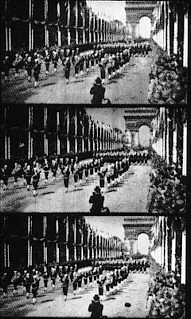
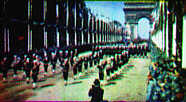



The Gaumont Chronochrome process was one of a number of attempts to record the full color spectrum using records of the three primary colors. This system utilized a camera with three lenses which took the red, green, and blue records simultaneously, thus fringing was not an inherant problem.
The black and white print was projected through three lenses and color filters which had to be converged on the screen. The system was capable of accurate color but the mechanics of the system prevented it from ever getting into commercial usage. The three frames recording each record were nearly the same size as the standard 35mm frame. Film consumption was about 2 1/2 times as much as conventional black and white photography.
The frames illustrated above are of an Armistace parade in Paris in 1918. From top to bottom, the colors associated with the black and white frames are Blue, Red, and Green
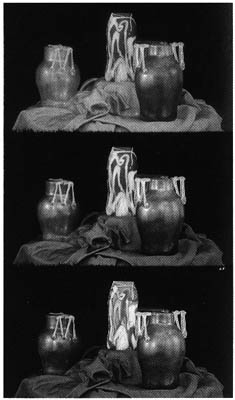
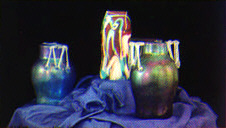
A demonstration film in Gaumont Chronochrome. Seem a little heavy on the blue? The choice of colors would be common for a system demonstrating its unique ability to record all three primary colors versus the blue starved two color systems.
Please patronize our sponsors
Similar Three Color Processes
Opticolor
(Franchita-Realita)
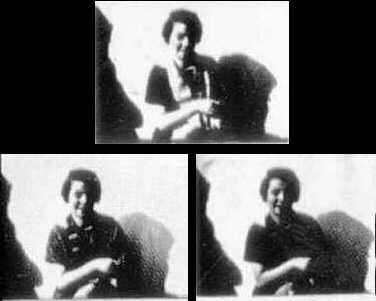
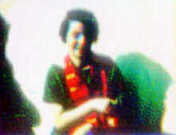
Opticolor recorded three images within the confines of a standard 35mm frame. It suffered obvious defects of poor definition (don't judge that from my poor scan), color fringing and registration problems associated with projecting three filtered pictures onto the screen. This image is from about 1935, by which time color films in 16mm would have exceeded the capabilities of Opticolor.
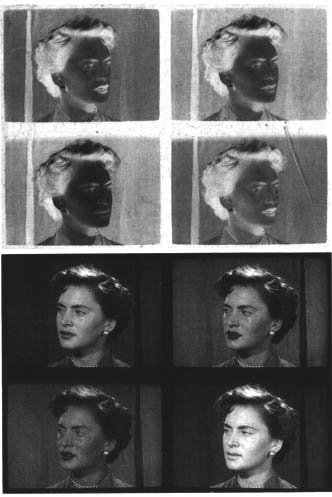
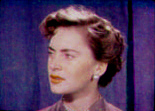

The Roux color system avoided wasting space on the film by recording two blue records. If a little bit of blue is good then a LOT of blue must be better. At top is the four-panel negative with the black & white print seen below. When projected through appropriate filters and aligned on the screen, the full color image, right, is seen. Note the use of a blue curtain behind the woman and her apparently violet colored blouse. These colors could not be accurately reproduced in any competing two color system, and perhaps not by any three-color system. Roux color used a non-standard wide film, probably 70mm. The image colors seen on the negative and print are: Top row - Green and Blue-Violet, Bottom row - Blue and Red. Blue-Violet is a difficult shade to reproduce in conventional three-color systems, so the use of a separate frame for that narrow part of the color spectrum may have been beneficial. The negative and positive images are of two separate frames. Both are illustrated in full color at the bottom. Note that the tonality is not identical. That's the nature of any sort of color photography, whether photo-mechanical, photo-chemical, or electronic. A slight variation in any of the color records can make dramatic differences in the appearance of the image on screen. Even the color of the projection light must be taken into consideration when producing any sort of print. The color image on the left was produced from the negative image at top and the color image on the right was produced from the positive image at the bottom. The results were substantially different even when using exactly the same method to create the pictures. Some manipulation of contrast and brightness was required to make the two images similar.
Black & white images duplicated from The International Encyclopedia of Film © 1972 Rainbird Reference Books Limited, London. The color images were created at The American WideScreen Museum and Film Technology Center, Houston, Texas, U.S.A. ©1996, 1998
Back to Additive Color Film Processes
Return to Start Page
©1997-1998 The American WideScreen Museum